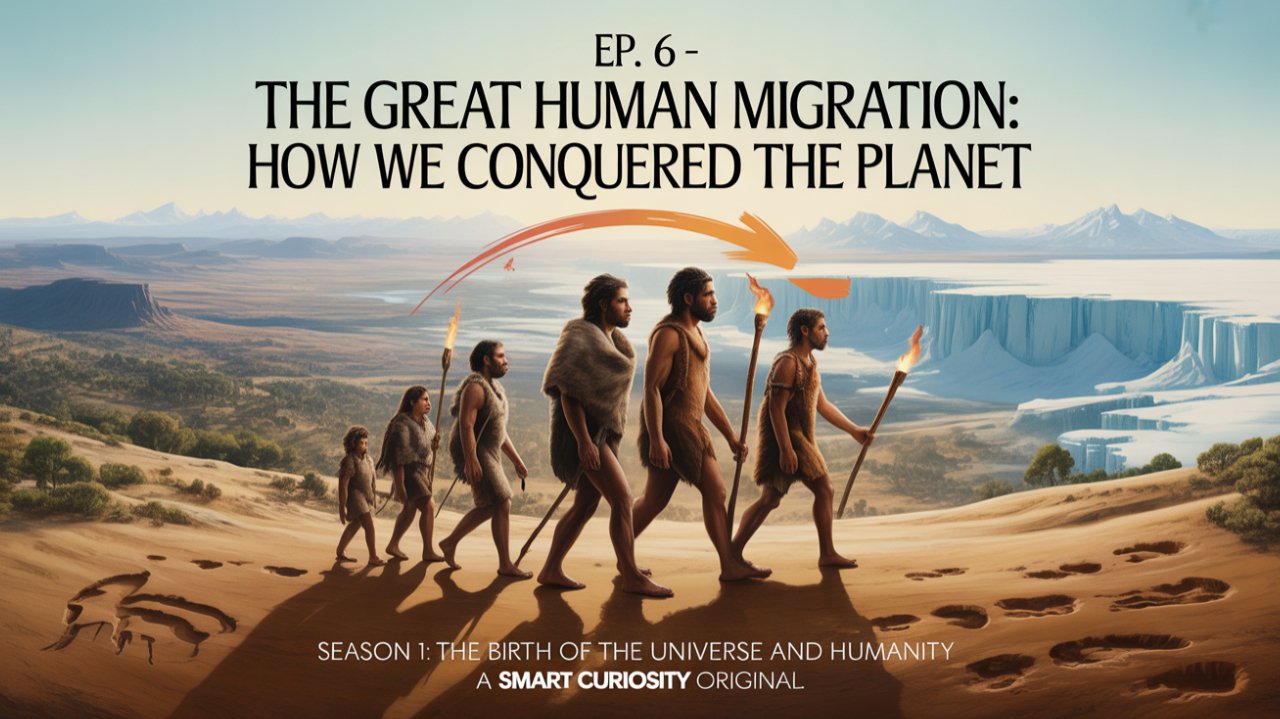How did we get here? How did one single species come to live on every continent, thrive in every climate, and build civilizations that can reach for the stars? Just look around you. The bustling cities, the quiet villages. The frozen tundra, the scorching deserts. Every face you see, every language you hear, is part of an unbelievable journey. A journey that started with a tiny group of hunter-gatherers in Africa and ended with us, all of us, spread across an entire planet.
This isn’t just a story about surviving; it’s the greatest journey ever told. It’s a 300,000-year epic that reveals how we, Homo sapiens, became the last human species standing. What pushed our ancestors out of their homeland? What challenges did they have to overcome? And what secrets, written in our DNA, tell the tale of their incredible odyssey? This is the story of us. This is the story of the great human migration.
The Cradle of Humanity (Africa)
Our story begins where all human stories do: in Africa. But this wasn’t a single, uniform landscape. Imagine a continent of incredible diversity vast savannas teeming with giant animals, dense rainforests, and sprawling deserts. It was in this crucible of changing environments that our species, Homo sapiens, was born. The oldest fossils we’ve found, from a site in Morocco called Jebel Irhoud, push the dawn of our kind back a staggering 300,000 years. These weren’t people you’d recognize on the street today. They had our characteristically flat, modern faces, but their braincases were longer, lower, more archaic. They were a work in progress, the first draft of you and me.
And they weren’t alone. For most of human history, our planet was home to several kinds of humans. In Europe and Asia, our stocky, powerful cousins, the Neanderthals, were masters of the cold Ice Age landscapes. In Asia, the mysterious Denisovans roamed a species we know about almost entirely from a few small bones and the genetic ghosts they left behind in our DNA. And even within Africa, other hominins like the small-brained Homo naledi may have still walked the earth. The world used to be a much more human place, just not with our kind of human.
So, what made our ancestors different? For a long time, we thought Homo sapiens were simply smarter, that we out-competed everyone else with sheer brainpower. But the real story is far more complex. Neanderthals had brains as large as ours, if not larger. They were sophisticated toolmakers, skilled hunters, and they cared for their sick and elderly. They were not the brutish cavemen of cartoons.
The key to our ancestors’ success wasn’t just a bigger brain, but maybe a different kind of brain. A brain wired for something revolutionary: complex, symbolic language and unprecedented social cooperation. Around 70,000 years ago, something seems to have clicked. Archaeologists see a sudden flowering of creativity in Africa. At sites like Blombos Cave in South Africa, we find the first hints of symbolic thought: pieces of ochre engraved with geometric patterns, shell beads perforated to be strung together and worn, and beautifully crafted stone tools. This wasn’t just about survival anymore; this was about identity, art, and culture. This was the dawn of us.
This new cultural and social toolkit gave our ancestors a unique edge. They could form larger social networks, share knowledge more effectively, and adapt to new challenges with incredible speed. This adaptability would become our species’ superpower. And they were going to need it, because Africa was no gentle cradle. It was a testing ground.
The ancient African climate was anything but stable. It swung wildly between wet, lush periods that created “green corridors” across the Sahara, and periods of extreme drought that fractured the landscape and isolated populations. These pressures were relentless. But they also forged resilience. To survive, our ancestors had to become masters of adaptation. It seems that before the final, successful push out of Africa, our species first learned to conquer every corner of its own continent, from dense forests to harsh deserts.
This expansion within Africa was critical training. By learning to thrive in such different environments, our ancestors honed their skills and strengthened the social networks that let them share information about resources and techniques. This created a feedback loop: new territories meant new connections, which accelerated cultural exchange and made our species even more versatile.
There had been earlier attempts to leave. Fossils from caves in Israel and a skull from Greece show that some Homo sapiens made it to the Middle East and even Southern Europe as early as 210,000 years ago. But these were failed expeditions. These pioneer populations seem to have died out, leaving no genetic trace in people alive today. They were ghosts pioneers who were ultimately reclaimed by the wilderness, or perhaps by established Neanderthal populations.
Why did they fail? Maybe they lacked the numbers to sustain themselves. Or maybe the climate turned against them. But the newest research suggests they hadn’t yet developed the profound adaptability that would allow their descendants to succeed.
The final, successful migration the one from which all non-Africans today descend was different. This wasn’t just a small band wandering off. This was an expansion fueled by a new kind of human: a cultural, symbolic, hyper-cooperative, and supremely adaptable human. Forged in the dynamic environments of Africa, our ancestors were now ready. They weren’t just following the food. They were ready to take on the world.
The Great Expansion
The First Steps Out
Sometime between 70,000 and 60,000 years ago, a small group of Homo sapiens, maybe only a few thousand people, left Africa for good. This wasn’t a single, organized expedition. It was likely a slow trickle of hunter-gatherer bands moving out of northeastern Africa and into Asia.
What drove them? Probably a mix of things. Population pressure, the pursuit of migrating herds, or maybe just simple curiosity that uniquely human desire to see what’s over the next hill. A brief warm, wet period likely helped, turning the deserts of North Africa and Arabia into green corridors that provided the resources needed to make the journey.
As they stepped into the Middle East, they entered a world that was already occupied. This was the heartland of the Neanderthals. For the first time, our ancestors came face-to-face with another intelligent human species on a large scale. What was that like? Our genetics paint a complex, and surprisingly intimate, picture. It wasn’t a simple story of war and replacement. It was a story of coexistence, competition, and interbreeding.
We know this because the proof is written in the DNA of almost everyone with ancestry outside of Africa, who carry between 1 and 2 percent Neanderthal DNA. This is a direct echo of encounters that happened tens of thousands of years ago. It tells us these two groups met and had children whose descendants are still here today.
This genetic exchange might have been critical for our survival. As our ancestors moved into Eurasia, they faced new diseases and climates. The genes they acquired from Neanderthals, who had been adapting to those very conditions for hundreds of thousands of years, may have been a vital survival kit. Some of this inherited DNA is linked to our immune system and our skin, helping us fast-track our adaptation to a world outside of Africa.
But the encounter wasn’t entirely peaceful. As Homo sapiens populations grew, they inevitably competed with Neanderthals for the best caves, hunting grounds, and food. Our ancestors’ larger social networks and perhaps more efficient hunting strategies may have given them a competitive edge over time. The story of their first steps out of Africa wasn’t one of simple conquest, but of a long, complex interaction that shaped the destiny of both species.
Conquering Asia and Meeting a New Cousin
Once our ancestors got a foothold in the Middle East, they didn’t stop. They spread out, splitting into two main streams. One group pushed north into the cold, arid steppes of Central Asia. But another, larger group took a different path: the coastal express.
This southern route was a prehistoric superhighway. Following the coastline of the Arabian Peninsula, through Persia, and into India, these pioneers found a rich, predictable source of food in the ocean. Shellfish, fish, and seabirds allowed populations to move relatively quickly along the shores of the Indian Ocean. By at least 60,000 years ago, modern humans had reached Southeast Asia, and recent finds suggest they were confidently exploring far inland much earlier than we previously thought.
As they moved through Asia, they entered a land of incredible diversity, from tropical rainforests to towering mountains. And just like before, they found they weren’t alone. This time, the human cousin they met was far more mysterious. In 2008, in a Siberian cave called Denisova, scientists found a tiny fragment of a pinky bone. When they sequenced its DNA, they were stunned. It belonged to a previously unknown group of archaic humans. They named them the Denisovans.
Since then, we’ve learned a bit more from a few massive molars and a jawbone found on the Tibetan Plateau. We now know Denisovans were widespread across Asia, from the freezing mountains of Siberia to the high-altitude plateaus of Tibet, and likely the humid forests of Southeast Asia.
And, just like with the Neanderthals, our ancestors interbred with them. The genetic evidence is undeniable. Traces of Denisovan DNA are found in people across Asia and Oceania today. In fact, some populations in Melanesia carry the highest percentage of archaic DNA in the world, with up to 5% of their genome coming from Denisovan ancestors.
Again, this was more than a historical curiosity. It had real-world consequences. One of the most striking examples is a gene that helps modern Tibetans survive in the low-oxygen environment of the high plateau. It turns out, that gene was inherited from Denisovans, who had adapted to life at high altitudes long before Homo sapiens ever arrived. By mixing with them, our ancestors got a ready-made genetic solution to a life-threatening challenge.
The conquest of Asia was a story of incredible adaptation and repeated encounters with other human forms. Our species proved its versatility, but these encounters also changed us, weaving the genetic legacy of our ancient cousins into our own DNA. The journey, however, was far from over. From the shores of Southeast Asia, our ancestors looked out at the Pacific and prepared to make a leap that would test them like never before.
The Island Continent: Journey to Australia
Of all the great migrations, the settlement of Australia is one of the most remarkable. It was a watershed moment, when our species went from being land travelers to seafaring pioneers.
During the last Ice Age, sea levels were much lower. The islands of Indonesia were connected to mainland Asia in a landmass called Sunda. Australia and New Guinea were joined together as a giant continent known as Sahul. But even at the lowest sea levels, Sunda and Sahul were never connected. A deep oceanic trench always separated them a water barrier that no land animal had ever managed to cross.
To reach Sahul, our ancestors had to do something unprecedented: they had to build watercraft and deliberately cross the open ocean, navigating from island to island to a land they couldn’t see. This wasn’t an accident. It was a planned, intentional act of exploration that required a huge cognitive leap. It implies they had complex language to coordinate, advanced knowledge to build sturdy boats, and sophisticated navigational skills to find their way.
The archaeology confirms how ancient this achievement was. At a rock shelter called Madjedbebe in northern Australia, artifacts have been dated to around 65,000 years ago. Whether it was then, or 42,000 years ago as other sites confirm, reaching Australia was a monumental feat that no other human species had ever managed.
When they arrived, they stepped into an alien world. Sahul was a continent of bizarre creatures, a land of giant marsupials known as megafauna. There were two-ton wombats, kangaroos that stood three meters tall, and terrifying marsupial lions. Armed with their intelligence and cooperative hunting strategies, our ancestors had to quickly learn how to survive and hunt in this entirely new ecosystem.
Their impact was profound. Within a few thousand years of their arrival, most of Australia’s giant megafauna had vanished. Scientists still debate the exact cause. Was it “overkill” from human hunting? Or was it changes to the landscape from human use of fire, which altered the habitats these animals relied on? It was likely a bit of both. But what’s certain is that the arrival of humans permanently reshaped the continent’s ecology.
The settlement of Australia is a powerful testament to the ingenuity and courage of Homo sapiens. They had crossed the final barrier of the Old World and proven that no ocean could contain their ambition. At the same time, another branch of the human family was turning west, towards a colder, harsher, but no less important frontier: Europe.
The European Frontier and the Neanderthal Enigma
While some groups were mastering the seas to reach Australia, others pushed west from the Middle East, venturing into Europe less than 55,000 years ago. But Europe was not an empty land. It was a continent in the grip of the last Ice Age a world of vast ice sheets, frozen tundra, and cold plains. And it was the Neanderthal’s world.
Neanderthals had dominated Europe for over 300,000 years. They were supremely adapted to the cold, with stocky bodies to conserve heat and large noses to warm the frigid air. They were skilled hunters of mammoth and woolly rhino, who made sophisticated tools, controlled fire, and buried their dead. They were the original Europeans.
The arrival of our ancestors set the stage for one of the most fascinating chapters in our history. For about 15,000 years, these two human species shared the continent. What happened during this long overlap?
As we know from our genetics, they interbred. But the relationship was likely a complex mix of everything from peaceful exchange to violent conflict. In some areas, it seems they lived side-by-side for millennia. We find archaeological sites where the toolkits of both species appear, suggesting a transfer of ideas. Some of the last Neanderthals even started producing more complex tools and ornaments, hinting they may have been learning from their new neighbors.
But the ultimate outcome is clear. As Homo sapiens populations grew, Neanderthal populations dwindled, retreating into isolated pockets before vanishing from the fossil record entirely around 30,000 years ago. Their extinction remains one of the great mysteries of human evolution. Why did they disappear after so many hundreds of thousands of years of success?
There’s no single answer. It was likely a combination of factors. The climate was a major player, with dramatic and abrupt swings that would have stressed the animals and plants Neanderthals relied on. Homo sapiens, with our more diverse toolkits and larger social networks, may have been better able to adapt.
Direct competition was almost certainly another factor. Neanderthals lived in smaller, more isolated groups. Homo sapiens seem to have had a demographic advantage, living in larger, more interconnected populations. Our ancestors may also have had more efficient hunting techniques, like spear-throwers, which allowed them to hunt more safely from a distance.
Finally, a more insidious threat may have been disease. Our ancestors would have carried pathogens from Africa to which Neanderthals had no immunity, and vice versa. This exchange could have been devastating for the smaller, less genetically diverse Neanderthal groups.
In the end, it may not have been a violent conquest, but a slow process of replacement and absorption. Some scholars suggest the last Neanderthals were simply genetically swamped, absorbed into the much larger Homo sapiens population. Their legacy lives on, not as a species, but as an echo in our own genome. With the Neanderthals gone, Homo sapiens was now the sole human ruler of the Old World. But one final frontier remained: a vast, untouched double continent, hidden across the icy waters of the north.
The Final Frontier: The Peopling of the Americas
The settlement of the Americas was the final great act in our species’ planetary expansion. It was an achievement that required crossing some of the harshest landscapes on Earth, and it happened with breathtaking speed. The journey began in the frozen world of Ice Age Siberia.
At the peak of the last Ice Age, around 20,000 years ago, so much of the world’s water was locked up in ice sheets that sea levels were over 100 meters lower than today. This exposed a vast landmass connecting Siberia to Alaska. This wasn’t a narrow bridge, but a huge subcontinent called Beringia a treeless steppe teeming with mammoth, bison, and horses.
Genetic evidence suggests a population of hunter-gatherers lived in isolation on Beringia for several thousand years. They were cut off from Asia by glaciers to their west, and blocked from entering the Americas by the massive ice sheets covering Canada. In this refuge, they developed the unique genetic signatures found in all Indigenous peoples of the Americas today.
Then, as the climate warmed, a path opened. For decades, the leading theory was that an “Ice-Free Corridor” opened up between the two great North American ice sheets, allowing people to walk south.
However, more and more evidence now supports an alternative route: the Coastal Migration Theory. This model suggests the first Americans didn’t wait for an inland corridor. Instead, they used boats to hop down the Pacific coastline. This “Kelp Highway” would have been a rich marine environment, allowing for a much faster migration. This theory helps explain how sites in South America, like Monte Verde in Chile, can be dated to 14,500 years ago seemingly too early for people to have walked the entire length of two continents.
The exact timing of the first arrival is still fiercely debated, but a consensus is growing that humans were in the Americas by at least 15,000 to 20,000 years ago. What’s undisputed is how fast they spread once they got south of the ice. Within just a couple of thousand years, humans had gone from Alaska to the southernmost tip of South America.
As they moved into these new lands, they encountered a continent filled with spectacular megafauna: giant ground sloths, massive short-faced bears, and iconic saber-toothed cats. The early Americans were formidable big-game hunters, famous for their beautifully crafted “Clovis points” stone spearheads found across North America.
And just as in Australia, the arrival of humans coincided with a mass extinction. By about 10,000 years ago, most of the Americas’ megafauna were gone. Again, the debate rages between human “overkill” and the “over-chill” of rapid climate change. Most likely, it was a deadly combination of the two.
With the peopling of the Americas, the great global migration was largely complete. In just 50,000 years since leaving Africa, our species had colonized every habitable continent. From the tropics of our homeland to the shores of the Arctic, from the deserts of Australia to the rainforests of the Amazon, we had proven ourselves to be the most adaptable species in the history of our world.
The Dawn of a Global Species
The end of the great migration marked a new beginning for humanity. We had conquered the planet, but in a way, the planet had also conquered us. Spreading across the globe forced us to adapt to an incredible array of environments, and this process forged the diversity of cultures, languages, and appearances we see in the human family today.
Our secrets to success weren’t brute strength or sharp claws. Our true weapons were our minds and our social bonds. We survived Ice Ages not with thick fur, but by learning to make tailored clothing and build warm shelters. We thrived by developing complex tools and, most importantly, by learning to cooperate and share knowledge on a scale no other species could manage. Language allowed us to pass vital information down through generations, meaning each new generation could stand on the shoulders of the last.
This isn’t some distant story. It’s your story. It’s my story. The genetic evidence is clear: every person with ancestry outside of Africa today is a descendant of those small bands who walked out of Africa some 60,000 years ago. And all of humanity, no matter where we live, traces its deepest roots back to a common African homeland. The echoes of this journey are inside our cells. The Neanderthal DNA in a European, the Denisovan DNA in a Melanesian, the unique genetic markers of the first Americans they are all living relics of this ancient odyssey. We are, quite literally, one big, complicated family.
This story, our shared story, is constantly being rewritten. Every new fossil find, every ancient genome sequenced, adds another page, revealing more of this incredible saga. The science of our past is always moving, and there are still so many mysteries left to solve. If this story blew your mind the way it does ours, please consider liking this video and subscribing. It helps us keep exploring these incredible histories. And let us know in the comments what part of this journey you find the most amazing.
From a vulnerable species in the African savanna to a global population of billions, our journey has been nothing short of miraculous. We faced down ice ages and super-volcanoes that drove other species to extinction. We outlasted all of our human cousins and inherited the Earth.
The great migration is the foundational story of all of us. It’s a powerful reminder that we are all travelers, all descendants of brave and curious people who dared to venture into the unknown. It’s a story of our shared heritage, a testament to the human spirit, and a legacy of connection that binds us all together. The journey of humanity is far from over. The next chapter is being written right now, by us.





